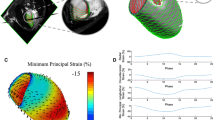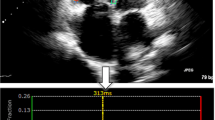Abstract
Three-dimensional (3D) strain analysis based on real-time 3-D echocardiography (RT3DE) has emerged as a novel technique to quantify regional myocardial function. The goal of this study was to evaluate accuracy of a novel model-based 3D tracking tool (eSie Volume Mechanics, Siemens Ultrasound, Mountain View, CA, USA) using sonomicrometry as an independent measure of cardiac deformation. Thirteen sheep were instrumented with microcrystals sutured to the epi- and endocardium of the inferolateral left ventricular wall to trace myocardial deformation along its three directional axes of motion. Paired acquisitions of RT3DE and sonomicrometry were made at baseline, during inotropic modulation and during myocardial ischemia. Accuracy of 3D strain measurements was quantified and expressed as level of agreement with sonomicrometry using linear regression and Bland–Altman analysis. Correlations between 3D strain analysis and sonomicrometry were good for longitudinal and circumferential strain components (r = 0.78 and r = 0.71) but poor for radial strain (r = 0.30). Accordingly, agreement (bias ± 2SD) was −5 ± 6 % for longitudinal, −5 ± 7 % for circumferential, and 15 ± 19 % for radial strain. Intra-observer variability was low for all components (intra-class correlation coefficients (ICC) of respectively 0.89, 0.88 and 0.95) while inter-observer variability was higher, in particular for radial strain (ICC = 0.41). The present study shows that 3D strain analysis provided good estimates of circumferential and longitudinal strain, while estimates of radial strain were less accurate between observers.



Similar content being viewed by others
References
Edvardsen T, Urheim S, Skulstad H, Steine K, Ihlen H, Smiseth OA (2002) Quantification of left ventricular systolic function by tissue doppler echocardiography: added value of measuring pre- and postejection velocities in ischemic myocardium. Circulation 105:2071–2077
Heimdal A, Støylen A, Torp H, Skjaerpe T (1998) Real-time strain rate imaging of the left ventricle by ultrasound. J Am Soc Echocardiogr 11:1013–1019
Kanai H, Hasegawa H, Chubachi N (1997) Noninvasive evaluation of local myocardial thickening and its color-coded imaging. IEEE Trans Ultrason Ferroelectr Freq Control 44:752–768
D’hooge J, Heimdal A, Jamal F, Kukulski T, Bijnens B, Rademakers F et al (2000) Regional strain and strain rate measurements by cardiac ultrasound: principles, implementation and limitations. Eur J Echocardiogr 1:154–170
Sutherland GR, Di Salvo G, Claus P, D’hooge J, Bijnens B (2004) Strain and strain rate imaging: a new clinical approach to quantifying regional myocardial function. J Am Soc Echocardiogr 17:788–802
Luis SA, Yamada A, Khandheria BK, Speranza V, Benjamin A, Ischenko M et al (2014) Use of three-dimensional speckle-tracking echocardiography for quantitative assessment of global left ventricular function: a comparative study to three-dimensional echocardiography. J Am Soc Echocardiogr 27:285–291
Reant P, Barbot L, Touche C, Dijos M, Arsac F, Pillois X et al (2012) Evaluation of global left ventricular systolic function using three-dimensional echocardiography speckle-tracking strain parameters. J Am Soc Echocardiogr 25:68–79
Crosby J, Amundsen BH, Hergum T, Remme EW, Langeland S, Torp H (2009) 3-D speckle tracking for assessment of regional left ventricular function. Ultrasound Med Biol 35:458–471
Elen A, Choi HF, Loeckx D, Gao H, Claus P, Suetens P et al (2008) Three-dimensional cardiac strain estimation using spatio-temporal elastic registration of ultrasound images: a feasibility study. IEEE Trans Med Imaging 27:1580–1591
Nesser H-J, Winter S (2009) Speckle tracking in the evaluation of left ventricular dyssynchrony. Echocardiography 26:324–336
Kleijn SA, Aly MFA, Terwee CB, van Rossum AC, Kamp O (2011) Three-dimensional speckle tracking echocardiography for automatic assessment of global and regional left ventricular function based on area strain. J Am Soc Echocardiogr 24:314–321
Seo Y, Ishizu T, Enomoto Y, Sugimori H, Yamamoto M, Machino T et al (2009) Validation of 3-dimensional speckle tracking imaging to quantify regional myocardial deformation. Circ Cardiovasc Imaging 2:451–459
Jasaityte R, Heyde B, D’hooge J (2013) Current state of three-dimensional myocardial strain estimation using echocardiography. J Am Soc Echocardiogr 26:15–28
Badano LP, Cucchini U, Muraru D, Al Nono O, Sarais C, Iliceto S (2013) Use of three-dimensional speckle tracking to assess left ventricular myocardial mechanics: inter-vendor consistency and reproducibility of strain measurements. Eur Heart J Cardiovasc Imaging 14:285–293
Farsalinos KE, Daraban AM, Ünlü S, Thomas JD, Badano LP, Voigt JU (2015) Head-to-Head comparison of global longitudinal strain measurements among nine different vendors: the EACVI/ASE inter-vendor comparison study. J Am Soc Echocardiogr 28:1171–1181
National Research Council (US) Committee for the Update of the Guide for the Care and Use of Laboratory Animals (2011) Guide for the care and use of laboratory animals, 8th edn. National Academies Press, Washington (DC)
Heyde B, Bouchez S, Thieren S, Vandenheuvel M, Jasaityte R, Barbosa D et al (2013) Elastic image registration to quantify 3-D regional myocardial deformation from volumetric ultrasound: experimental validation in an animal model. Ultrasound Med Biol 39:1688–1697
Theroux P, Ross J, Franklin D, Kemper WS, Sasyama S (1976) Regional myocardial function in the conscious dog during acute coronary occlusion and responses to morphine, propranolol, nitroglycerin, and lidocaine. Circulation 53:302–314
Cerqueira MD, Weissman NJ, Dilsizian V, Jacobs AK (2002) Standardized Myocardial segmentation and nomenclature for tomographic imaging of the heart: a statement for healthcare professionals from the cardiac imaging committee of the council on clinical cardiology of the American Heart Association. Circulation 105:539–542
Pérez de Isla L, Balcones DV, Fernández-Golfín C, Marcos-Alberca P, Almería C, Rodrigo JL et al (2009) Three-dimensional-wall motion tracking: a new and faster tool for myocardial strain assessment: comparison with two-dimensional-wall motion tracking. J Am Soc Echocardiogr 22:325–330
Maffessanti F, Nesser H-J, Weinert L, Steringer-Mascherbauer R, Niel J, Gorissen W et al (2009) Quantitative evaluation of regional left ventricular function using three-dimensional speckle tracking echocardiography in patients with and without heart disease. Am J Cardiol 104:1755–1762
Duan Q, Parker KM, Lorsakul A, Angelini ED, Hyodo E, Homma S et al (2009) Quantitative validation of optical flow based myocardial strain measures using sonomicrometry. Proc IEEE Int Symp Biomed Imaging 2009:454–457
Langeland S, Wouters PF, Claus P, Leather HA, Bijnens B, Sutherland GR et al (2006) Experimental assessment of a new research tool for the estimation of two-dimensional myocardial strain. Ultrasound Med Biol 32:1509–1513
Seo Y, Ishizu T, Enomoto Y, Sugimori H, Aonuma K (2011) Endocardial Surface area tracking for assessment of regional lv wall deformation with 3D speckle tracking imaging. JACC Cardiovasc Imaging 4:358–365
Langeland S, D’hooge J, Wouters PF, Leather HA, Claus P, Bijnens B et al (2005) Experimental validation of a new ultrasound method for the simultaneous assessment of radial and longitudinal myocardial deformation independent of insonation angle. Circulation 112:2157–2162
Rösner A, Barbosa D, Aaersæther E, Kjønås D, Schirmer H, D’hooge J (2015) The influence of frame rate on two-dimensional speckle-tracking strain measurements: a study on silico-simulated models and images recorded in patients. Eur Heart J Cardiovasc Imaging 16:1137–1147
Gayat E, Ahmad H, Weinert L, Lang RM, Mor-Avi V (2011) Reproducibility and inter-vendor variability of left ventricular deformation measurements by three-dimensional speckle-tracking echocardiography. J Am Soc Echocardiogr 24:878–885
Voigt J-U, Pedrizzetti G, Lysyansky P, Marwick TH, Houle H, Baumann R et al (2015) Definitions for a common standard for 2D speckle tracking echocardiography: consensus document of the EACVI/ASE/Industry task force to standardize deformation imaging. J Am Soc Echocardiogr 28:183–193
Yang L, Georgescu B, Zheng Y, Wang Y, Meer P, Comaniciu D (2011) Prediction based collaborative trackers (PCT): a robust and accurate approach toward 3D medical object tracking. IEEE Trans Med Imaging 30:1921–1932
Cikes M, Tong L, Sutherland GR, D’hooge J (2014) Ultrafast cardiac ultrasound imaging: technical principles, applications, and clinical benefits. JACC Cardiovasc Imaging 7:812–823
Hjertaas JJ, Fosså H, Dybdahl GL, Grüner R, Lunde P, Matre K (2013) Accuracy of real-time single- and multi-beat 3-d speckle tracking echocardiography in vitro. Ultrasound Med Biol 39:1006–1014
Muraru D, Badano LP (2014) Quantitative analysis of the left ventricle by echocardiography in daily practice: as simple as possible, but not simpler. J Am Soc Echocardiogr 27:1025–1028
Funding
The work of B. Heyde was funded by the FWO-Flanders Research Fund under Grant G.0693.09.
Author information
Authors and Affiliations
Corresponding author
Ethics declarations
Conflict of interest
H. Houle and Y. Wang are part of the Ultrasound Division of Siemens Medical Solutions. The other authors declare they have no conflict of interest.
Ethical approval
This study conformed with the Public Health Service Policy on Humane Care and Use of Laboratory Animals published by the Office of Laboratory Animal Welfare of the United States National Institutes of Health [16] and was approved by the local ethics committee (Ethische Commissie Dierproeven, Ghent University, Ghent, Belgium).
Rights and permissions
About this article
Cite this article
Bouchez, S., Heyde, B., Barbosa, D. et al. In-vivo validation of a new clinical tool to quantify three-dimensional myocardial strain using ultrasound. Int J Cardiovasc Imaging 32, 1707–1714 (2016). https://doi.org/10.1007/s10554-016-0962-5
Received:
Accepted:
Published:
Issue Date:
DOI: https://doi.org/10.1007/s10554-016-0962-5




